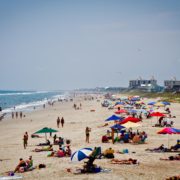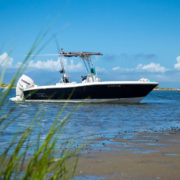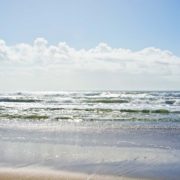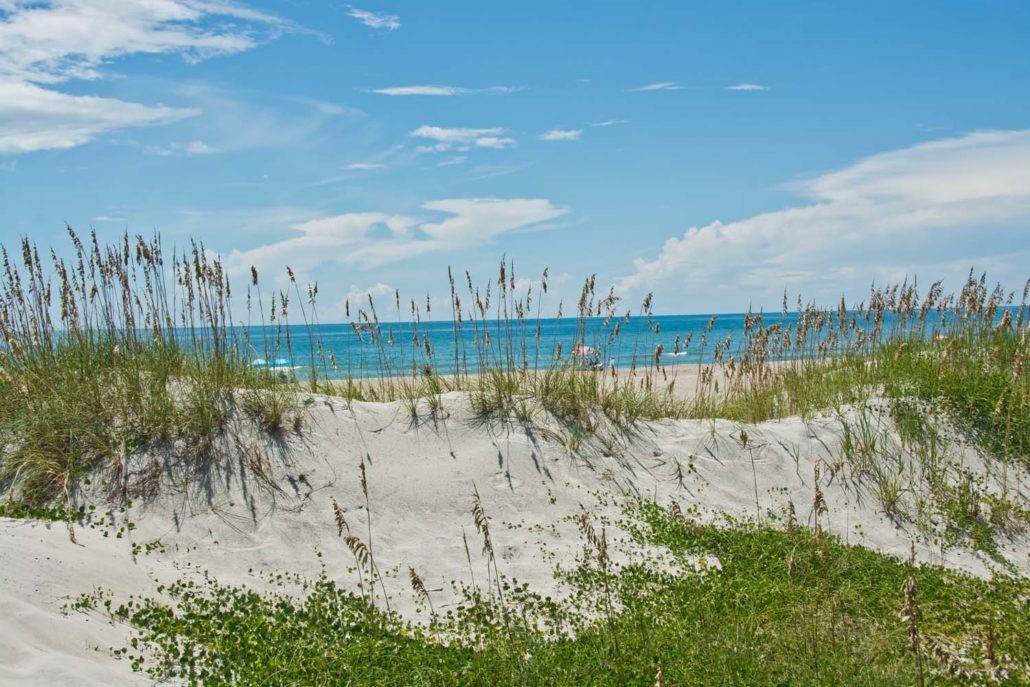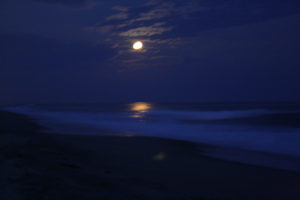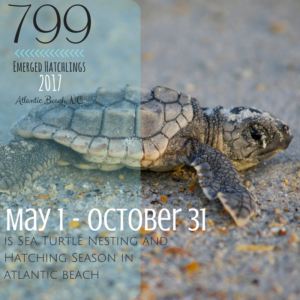Loggerhead Sea Turtles
Turtle Tracks
There are only seven species of sea turtles worldwide, and six are listed as threatened or endangered in the United States. Of these seven species, the most common in North Carolina is the loggerhead sea turtle. Only loggerhead, green, and leather-back sea turtles lay their eggs on North Carolina beaches. However, Emerald Isle and Atlantic Beach are very well known for being the home of the loggerhead sea turtle.
When a mother loggerhead sea turtle is ready to lay her eggs, she will migrate to the shore. In ocean waters close to the Emerald Isle and Atlantic Beach nesting sands, females will mate with one or more males, and roughly one month later are ready to lay their eggs. Females nest several times in a single season, but will only nest every second or third year. These mothers generally emerge from the ocean at night to lay their eggs as a way to avoid daytime predators and the hot summer sun. Once she is on the beach, she may take an hour or more to carefully dig her nest approximately 18 inches deep in the sand. Each time they nest, the mother loggerheads lay upwards of 100 leathery eggs in this hole, cover them with sand, and then return to the ocean, leaving the eggs to incubate on the beach. After about two months, the baby turtles will start to make their way into the world. The hatchlings will emerge from the nest and scramble to the ocean where they remain for about 15 to 30 years to then return to our Crystal Coast and lay eggs of their own.
Sea turtles can live to be over 50 years old; however, they have a very low survival rate. Only about one in 1,000 babies will live to have hatchlings of their own. Many sea turtle populations are declining. The existing seven species face different dangers, both on our Emerald Isle and Atlantic Beach nesting areas and in the ocean. Some of the threats this endangered species encounters in North Carolina include but are not limited to:
- Development and heavy traffic on beaches (that’s us!) that can disturb adults or destroy incubating eggs.
- Indirect capture by our fishermen in nets, which can lead to injury or death.
- Accidental collisions with our boaters’ vessels.
- Beach clean-up and re-nourishment activities that can uncover or compact sea turtle nests.
- Our litter! General ocean pollution hurts these beautiful creatures when they return to the crystal blue waters of our coast.
Nesting and Hatching
Emerald Isle & Atlantic Beach host a Sea Turtle Protection Program with over 100 volunteers! They help to locate and protect the nest sites and help the babies return to the surf. They walk the entire Emerald Isle (12.5 mi) and Atlantic Beach (4.5 mi)shores early every morning during this season searching for evidence of sea turtles coming ashore during the night to lay her eggs.
Biologists and volunteers mark and observe nests. The nest sites are marked off by flagging tape and a large yellow post with the nest number on it. Because these are a threatened and endangered species, the Program is not permitted to advertise the exact locations of nests nor the dates of hatching. However, the stakes and flagging are clearly visible along the beach – just look back towards the dunes, but don’t go too close!
Around the time of hatching, volunteers dig a trench about two feet wide to help guide the baby sea turtles to the ocean. Please do not disturb these trenching areas – these trenches will help guide the hatchlings toward the ocean if the volunteers are not there to help. No one knows the exact time the babies will come out of the nest, so once the trench has been dug, the volunteers will start sitting at the nest from dusk to midnight.
Once they are ready and the area is cool and quiet, the nest will start to “boil” – the sand will look like a boiling pot of water! The baby loggerheads will come up from under the sand, generally in a group. They will venture down to our crystal waters and learn to swim with the current, be a good navigator, be well traveled, and most importantly – age gracefully.
The volunteers do not touch the hatchlings – they just guide them to the ocean. These newborn sea turtles will go towards the brightest thing they see – they are guided to the ocean at night by the glistening light of the moon shining onto the surface of the crashing, foaming waves.
What You Can Do To Help
REMOVE all tents, toys, and beach gear overnight!
FILL IN ALL HOLES that you, your children, and even your dogs may dig – mother turtles can get stuck AND people at night can be seriously injured!
KEEP OUTSIDE LIGHTS OFF AT NIGHT – they disturb nesting mother turtles and distract hatching baby turtles toward the light but away from the ocean which is where they need to go!
Please STAY BACK AT LEAST 30 FEET. NO FLASHLIGHTS OR FLASH PHOTOGRAPHY … If you see a nesting or hatching sea turtle please STAY QUIET, sit down, and enjoy the show! You are witnessing something amazing happening!
PICK UP TRASH, especially plastic bags – turtles think that they are jellyfish which is their main food source and eat them and get sick!
CALL THE POLICE at (252) 354-2021 [Emerald Isle] or (252) 726-2523 [Atlantic Beach] if you see a nesting or hatching turtle or anyone disturbing a marked turtle nest area!
Follow Us On Our Nest Count!
Follow us on Facebook and Twitter to see when we update our nest count!



